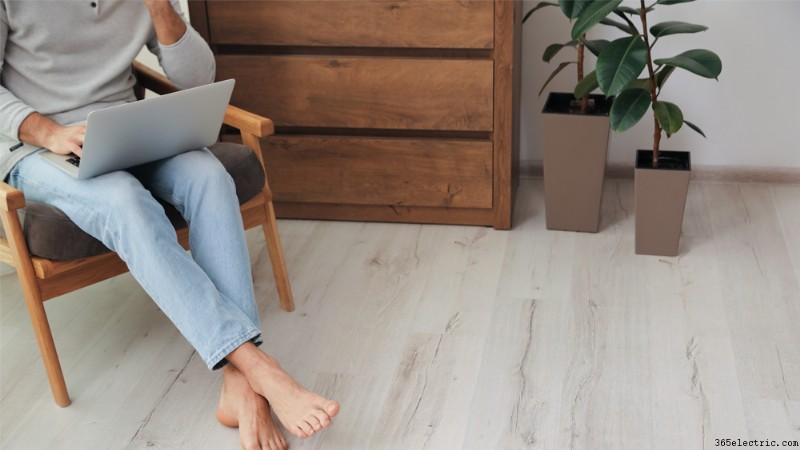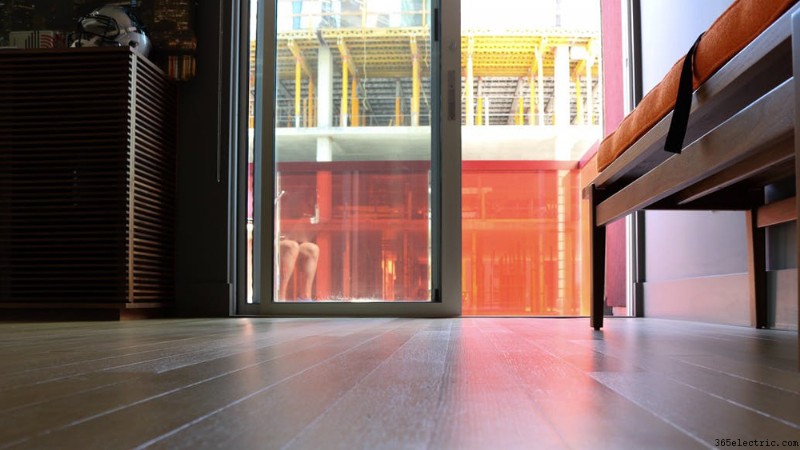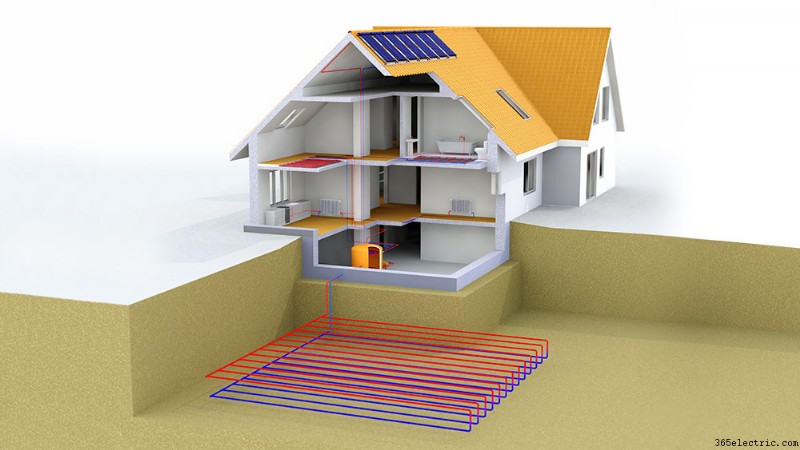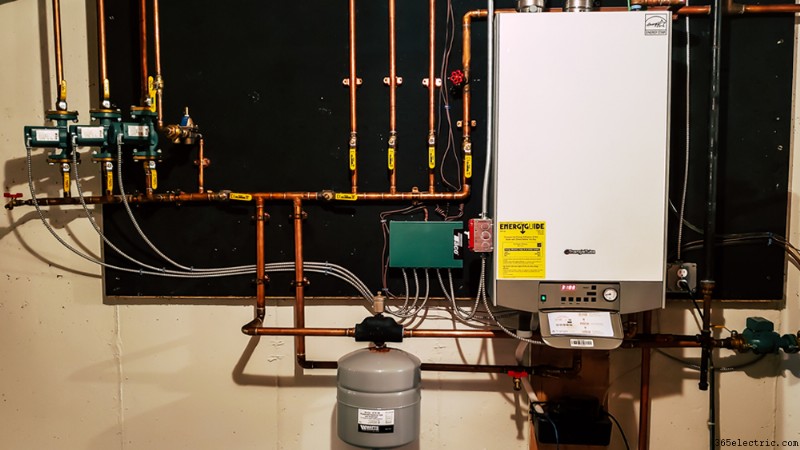Os sistemas de aquecimento hidrônicos são um dos sistemas mais eficientes em termos energéticos.

Se você já entrou em uma casa que tem a temperatura certa, mas não tem uma ventilação ou bomba de calor à vista e se perguntou qual é o segredo, é este - um sistema de aquecimento hidrônico!
Os sistemas de aquecimento hidrônicos são uma solução ideal se você estiver procurando por um sistema de aquecimento limpo e eficiente em termos energéticos para sua casa. Como qualquer outro sistema por aí, isso também tem vantagens e desvantagens. Mas antes de chegarmos a isso, vamos primeiro ver o que é o aquecimento hidrônico e como ele funciona.
O que é aquecimento hidrônico?
Um sistema de aquecimento hidrônico, também conhecido como aquecimento radiante, depende de água ou outros líquidos para aquecer sua casa. Esses sistemas constituem uma fonte de calor e uma rede de tubos que transportam o fluido aquecido para outras partes da sua casa.
Os sistemas de aquecimento hidrônico podem ser usados como sistemas de piso radiante, sistemas de aquecimento de parede radiante, aquecedores hidrônicos de rodapé, aquecedores de toalhas hidrônicos ou radiadores.
Edifícios maiores muitas vezes podem se beneficiar deste sistema usando-o com caldeiras. Muitas casas residenciais no norte também adotaram esse sistema devido às longas estações de aquecimento. As pessoas que vivem em áreas com estações de aquecimento mais curtas também usam esse sistema em uma escala muito menor.
Como funcionam os sistemas de aquecimento hidrônico?

A transferência de calor pode ocorrer de três maneiras:condução, convecção e radiação.
Os sistemas de aquecimento hidrônico usam condução e radiação para manter suas casas aquecidas.
Em primeiro lugar, uma caldeira usa a condução para aquecer água ou outro líquido usado como meio de transferência. Então, à medida que esse líquido passa pelo sistema, ele aquece tudo o que toca por condução. Por último, quando este líquido aquecido atinge radiadores, painéis de aquecimento de parede, etc., utiliza radiação para aquecer o seu espaço.
Leia este artigo para uma comparação detalhada entre calor radiante e ar forçado.
Benefícios do sistema de aquecimento hidrônico
Os sistemas de aquecimento hidrônico são muito eficientes, mas isso não é tudo. Esses sistemas têm uma infinidade de benefícios.
1. Crie zonas separadas
Os sistemas hidrônicos permitem que você crie zonas de temperatura para aumentar seu conforto.
Por exemplo, em vez de ter um termostato em toda a sua casa, você pode ter um termostato de duas zonas para variar as temperaturas em diferentes cômodos. As zonas são uma ótima ideia se você mora com alguém que tem outras preferências de temperatura além de você.
2. Níveis de umidade
Os sistemas de ar forçado podem extrair a umidade do ar enquanto o aquece, levando a níveis de umidade desequilibrados em sua casa. Os sistemas de aquecimento hidrônico não secam sua casa como outros sistemas de aquecimento radiante, pois usam um líquido em um sistema fechado para aquecer sua casa.
3. Pisos quentes

Os sistemas de aquecimento hidrônico podem funcionar como aquecimento radiante do piso para deixar o piso mais quente, para que você não precise mais ter medo de sair da cama nas manhãs frias. Os tubos podem ser colocados sob o piso ou em lajes de concreto, e o piso atua como um condutor para mantê-lo confortável.
4. Operação silenciosa
Os sistemas hidrônicos não deslocam o ar para aquecer sua casa, ao contrário dos sistemas de aquecimento de ar forçado. Portanto, você não só não precisa ficar ouvindo o fluxo de ar que passa pelo sistema, mas também não precisa se preocupar com os sons de um forno acendendo ou gemidos dos dutos frios enquanto o ar quente passa eles. Então, você está praticamente livre de todos os vários sons de ar condicionado que você tem que suportar em outros sistemas de aquecimento.
5. Sem dutos
Ductwork can take up quite a bit of space in your walls and ceilings. Additionally, ducts can also be expensive and messy to install and maintain. Instead, hydronic heating system tubes can be installed in the wall or attached to floor joists. These pipes can also be routed around the existing pipework.
6. No Dust, Pollen, or Allergens
Forced air systems push air into your room to regulate the climate. Unfortunately, this airflow can often bring dust, pollen, pet dander, or other indoor air pollutants, or the brisk moving air can stir up allergens in the room. If you don’t maintain your ducts or change your air filters regularly, this situation can worsen. On the other hand, hydronic heating systems do not rely on ducts, don’t displace air, and are much cleaner.
7. Energy Efficiency
Air isn’t the best heat conductor. It can lose energy as it travels through ducts or leaks through gaps, leading to heat loss. In contrast, water needs less energy to heat since it absorbs heat better and retains the heat for longer. Compared to forced-air heating systems, a hydronic heating system is about 25% more efficient.
8. Hydronic Systems Are Durable
Normal HVAC systems have a lot of moving and mechanical parts, which means they need repairs more often. Instead, hydronic heating systems do not have many mechanical parts, do not need much maintenance, and are more likely to last a long time.
9. Warmer Where It Matters
Hydronic systems are commonly used as radiant floor systems, baseboard heaters, or radiators. Even in radiant wall heating systems, the tubes are installed close to the ground, where you are. Forced air systems are usually at a distance, making hydronic heating systems a better solution.
10. Even Heating
Forced air heating systems use air displacement to keep you warm. However, these systems move air briskly, and the subsequent drafts and breezes may result in uneven heating or cooling around your home. Hydronic heating systems eradicate this issue by using radiation rather than air to keep you warm.
Disadvantages of Hydronic Heating System
Hydronic systems have many perks, but they aren’t without their downsides.
1. Long Heating Time
While water does absorb heat better than air, the heated water needs to travel through the whole system to warm your home up. This process can take quite a long time, and you’ll have to wait longer to benefit from the warmth. Due to this issue, hydronic heating systems are better suited for moderate climates or when consistent temperatures are needed.
2. Space Requirements
Baseboard hydronic systems require additional space on the wall and interrupt your interior. Hydronic heating systems also need a network of pipes to transfer heat to different parts of your home. These pipes can take up a significant amount of space in your home. However, the space required is only about half an inch which is still much lesser than the space ducts take up. This may not be an issue when you’re constructing a new home but adding this system to an existing home may require tearing up floors or walls.
3. Require Maintenance
All closed-loop water heating systems need an expansion tank for safety. These tanks have to be occasionally drained to work efficiently. Since this maintenance task is one of the only ones that hydronic heating systems need, it’s easy to look past, prompting efficiency issues.
4. Hard to Access Piping if a Problem Comes Up
With hydronic heating systems, there’s a slight risk that pipes in the system might leak or burst. While this is a highly unlikely situation, it still poses a threat to the system’s working and your home’s building elements. In addition, the pipes are hidden away under the floor or behind the walls or ceiling, making repairs of this sort a difficult and expensive process.
5. Higher Installation Costs Upfront
Installing a hydronic heating system into an already built home can be very expensive. It requires professional builders, and you will need access to your floor joists. The alternative is to remove the floor or the drywall and then reinstall them with the system installed. If you’re looking to refurbish your home or are building a new house, installing the system in those instances won’t be as cost-restrictive.
6. No Ductwork for Air Conditioning
Since radiant cooling isn’t a widely popular or efficient system, most people only use hydronic systems for heating. So, if you live in an area where you would like central air conditioning, opting for radiant heating isn’t a good idea. In addition, installing two separate systems for heating and cooling is quite expensive.
7. Water Could Potentially Freeze During Power Outage
If you live in an area where temperatures can likely fall below the freezing point of water, you will have to worry about ice damaging the components during power outages or when you’re away. You can solve the latter issue if you own a mini-split paired with a smart AC controller that can keep your pipes from freezing even when you’re on vacation.
Here are 20 tips on what to do during a winter power outage.
8. Requires Careful Planning Before Installation
Extensive planning is necessary to ensure that a hydronic heating system will work efficiently. For instance, it’s important to keep the warming elements closer to the ground where people are when installing radiant wall heating. If they’re too high up, the generated heat will be of no use to the inhabitants of the room since radiant heat only warms objects in its line of sight.
9. Lack of Ventilation
Without air circulation, you’ll soon have stagnant air filling your home up, leading to pent-up pollutants and bad odors in your home. To improve the indoor air quality of your home, you can open up windows and doors to allow adequate home ventilation.
10. Furniture Can Be a Hindrance
Radiant heating warms objects by radiation, and the things need to be in the line of sight for them to work efficiently. For example, furniture pulled up against the wall (in the case of radiant wall heating) or thick carpets that act as insulators can bring down the heating abilities of the system.
If now you’ve made up your mind to get a hydronic heating system for your home, then let’s look at its different types.
Types of Hydronic Radiant Heating Systems

Hydronic heating systems have seven basic components that work together to work efficiently. In addition, these components can have several variations that allow you to customize the system according to your needs.
- Boiler: The boiler is the central part of your system and is the means to heat the liquid.
- Liquid medium: Traditionally, most systems use water as a heat transfer medium, although some can use other liquids or antifreeze mixes.
- Thermostat: It controls the temperature in the system and decides when to turn the system on or off to control the climate better.
- Manifold: A plumbing manifold is a hub for directing the water flow in the system and is connected to the thermostat.
- Tubing: The tubes for carrying the liquid medium are usually made of PEX (cross-linked polyethylene) or some other form of plastic rather than copper or different types of rigid tubing.
- Heat Exchanger: A heat exchanger transfers the heat from the pipes to the inside of the house.
- Pump: To maintain a steady flow of heated liquid and constantly replenish the room’s warmth, a pump is used to push the fluid through the pipes.
Some of the variations available for boilers, liquid medium, and heat exchangers are as follows:
Boiler Options

An efficient boiler is the cornerstone of any hydronic heating system that works without heat loss or wasting energy. Some of the options available in boilers are as follows:
- Tankless Hydronic Water Heaters: These heaters are much smaller than the traditional tankless water heaters and work by heating water through their pipes. Since these tanks don’t have a storage tank for retaining water, they provide an on-demand hot water supply.
- Combined Hot Water and Heating Systems Boiler: Also known as combi boilers, these boilers combine a high-efficiency water heater with a central heating boiler. Combi boilers are similar to tankless water heaters because they don’t have a water storage tank.
- Solar Water Heater: Solar heaters will seldom provide enough heat to run the system alone. But when combined with your boiler, they can increase the energy efficiency of your system. Solar panels heat liquid that runs through pipes within a storage tank. This process creates a stream of pre-heated water that will not require much energy from the boiler to reach the right temperature.
- Heat Pumps: Heat pumps use the natural warmth of the ground or air to pre-heat water and make it easier for your boiler to heat the water. There are several different heat pumps that can use varying heat sources like air, ground, or water.
Liquid Options
The liquid medium for the transfer of heat can also vary across systems. Traditionally, most hydronic heating systems have used hot water, which remains the norm today. However, some modern systems also use glycol or other liquids with antifreeze properties. Incorporating these liquids into the system can protect the liquid from freezing in exposed pipes and increase the boiling point.
Heating Exchangers Options and Their Locations

Hydronic heating systems can have several heat exchangers to deliver heat to your living space.
- Underfloor Radiant System: Floor heating systems are one of the most common types of hydronic heating systems due to their ability to provide consistent and comfortable heating throughout your home.
- Baseboard Heaters and Radiators: Hydronic baseboard heaters and radiators are easier to install than floor heating systems in built homes.
- Walls and Ceilings: Like in-floor heating systems, hydronic heating systems can be installed behind walls or in the ceiling to heat any room. However, wall and radiant ceiling systems often use electricity instead of hydronic systems due to the possibility of water damage.
Hydronic heating systems are a great heating option for anyone looking for energy-efficient and even heating. There are many benefits these systems offer other than energy efficiency, such as quiet and clean heating. However, the system also has downsides like an expensive upfront installation cost and air stagnation. But, all in all, these systems are quite efficient!





